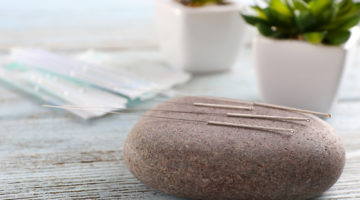You love your cat, but you don’t love all the hair on your carpets, upholstery and your best suit. These holistic approaches to excessive shedding will keep her healthier and you happier.
“Some days it seems like my cat flings fur at my black coat like a porcupine flings quills,” Judith says. “He’s mostly white, so it really shows up and it’s very hard to get off.”
Every cat sheds, but if yours seems to be losing an excessive amount of fur, it’s time to do a little investigating. Too much hair loss can be a symptom of an underlying problem. Genetics, illness, poor nutrition, environmental toxins and stress all play a role in your cat’s overall health, and can affect the condition of her coat.
1.First of all, a trip to the veterinarian for a check-up is in order. The vet will look for hormonal or thyroid problems and will check for fleas and other parasites. Blood tests may not pinpoint the answer but could rule out a number of causes. Holistic practitioners look at the big picture. Some, like veterinarian Dr. Paul McCutcheon, can analyze your cat’s hair to see if there are heavy metal or mineral imbalances in his body. This non-invasive procedure can reveal information from the past three or four months.
2.Try a change of diet. If your cat has been eating the same food for years, he may have become sensitive to one or more of the ingredients, causing allergy, skin issues and excessive shedding. Read the labels on all foods. Look for ingredients you recognize – chicken or other meats should be listed first. Key words to avoid are by-products, ground meal, gluten, artificial colors, corn and wheat. Foods made with natural ingredients and few or no fillers or grains are much healthier than cheap commercial foods. Premium packaged foods, raw or home-cooked diets are best. “The diet should be changed slowly,” says Jodi Ziskin, holistic nutritionist and wellness consultant. “Start with 75% of the current food mixed in with 25% of the new. Every couple of days add more of the new and less of the old. The process can take two or three weeks. During this time, the body will be going through a detox or ‘healing crisis.’ Your cat may shed a bit more as her body rids itself of toxins. This can last for several days but when it’s over, your cat will have a shiny, healthy coat.”
3.Make sure your cat gets enough water. Most cats get needed fluids from their food, not the water bowl. A wet diet is preferable to one that’s entirely dry. You might want to try a dehydrated or freeze-dried food with the proper balance of meat and vegetables (about 90% meat, 10% vegetables and fruits). Rehydrating helps add needed water to the diet. Also make sure your cat has 24/7 access to fresh, filtered water.
4.When your cat’s shedding problem is food related, he may need supplements to jump start his improvement. “Add an Omega 3 oil to whatever diet you choose,” says Jodi. “There are wild salmon oils on the market, made for cats and dogs, or you can use cod liver oil, organic first cold pressed flaxseed oil, or borage oil. Another wonderful oil that is becoming quite popular is emu oil. It can be used both internally and externally.” These oils help improve skin and coat health.
5.Environmental factors can affect your cat’s coat health. Fabric softener, laundry soap, floor wax or carpet shampoo, air fresheners, candles, bath soap or body lotions can trigger an allergic reaction in your cat that may lead to skin problems and excess shedding. Paint, new carpet, glue, and even new cat toys might also contribute to the hairy problem. Try to use as many non-toxic household cleaners, building materials and personal care products as you can.
6.Stress is another culprit. “Look at everything,” says veterinarian Dr. McCutcheon. “Routine checkups will not uncover stress problems that may be emotional, environmental or a product of a poor diet.” A child moving away from home for the first time can stress your cat just as much as an obvious reason like thunder or fireworks. And a stray cat seen through the window has stressed many an indoor cat. Identify potential stressors and either eliminate or minimize them.
If your cat has been eating the same food for years, he may have become sensitive to one or more of the ingredients, causing allergy, skin issues and excessive shedding.
Even if you think you see a smirk on your cat’s face as her white hair coats your black pants, excessive shedding is not a planned event but a symptom of a larger problem. Finding the cause and implementing some changes will help keep your clothes and carpets free of fur, while improving her overall well being.







No Comment